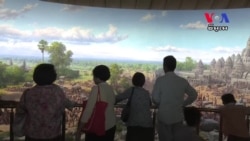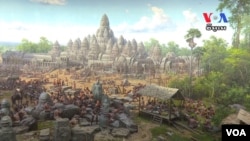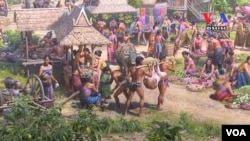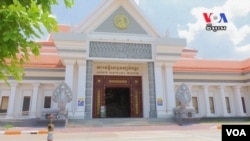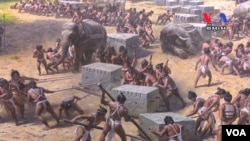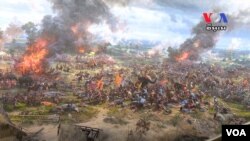The wow moment is the 13-meter-high, 123-meter-long, 360-degree wall mural depicting thousands of warriors and artisans at war and work in Cambodia’s 12th century Angkorian Empire.
Though the mural, or cyclorama, is painted on walls only several meters from the circular visitor viewing deck, the effect is a deep three-dimensional immersion in an ancient landscape. A diorama of artificial tropical trees, plants and huts blend space and time between the viewer and the walls, taking the eyes to a far-off horizon.
Welcome to the centerpiece of North Korea’s Angkor Panorama Museum in Siem Reap, Cambodia, which opened in December.
The mural took 63 painters from the most famous school of political artistry in North Korea and two years to complete. The result is so captivating that visitors on a recent excursion to the museum expressed doubts as to whether it was the work of mere mortals, brushes and paint, wondering if there could be some sneaky video projection involved.
“Amazing! I can see everything…. just sitting here in one place you can see everything,” gushed Keo Samoun from East Sras Chhouk village in Phnom Srok district, Banteay Meanchey province.
Keo Samoun was at the museum after visiting Angkor Wat and Bayon Temple. The museum, she said, helped placed the temples in an historical landscape. In addition, she added, it was easier to visit the museum than some of the far-flung temples dotted around the province.
“Amazing! I have never seen anyone paint anything like this. Amazing. Absolutely amazing!” said Thoam Manun Tho, a Buddhist monk visiting the museum. Monks are not usually known for near-delirious outburst of art appreciation.
Amazing is a word repeated often at the museum, which is a joint-venture between the Cambodian government and North Korea’s Mansudae Art Studio in Pyongyang. Mansudae is a political art “factory” founded in 1959 to extoll the revolutionary virtues of North Korea and its ruling family, which has expanded overseas in a bid to raise much-needed foreign capital for the isolated regime of Kim Jong-un.
Mansudae does things on a vast scale, much like its cyclorama in Siem Reap.
“With a labor force of approximately 4,000 people, 1,000 of which [are] artists, and an area of over 120,000 square meters, 80,000 of which indoor, the Mansudae Art Studio is probably the largest art production center in the world and by far the largest and most important of the country,” Mansudae states on its website.
The Angkor Panorama Museum is Socialist Realist art transported back to a time when Khmer warriors battled with their neighbors using spears, swords and huge fighting elephants. A time when the Khmer empire built stunning temples, which are today, UNESCO World Heritage sites.
“[Visitors] feel as if they are right there during the Angkor era. They feel as if they are with the people selling vegetables; those on the fighting elephants in the painting,” Yit Chandaroat, vice executive director of Angkor Panorama Museum, told VOA Khmer.
Yit Chandaroat believes that a visit to the museum should come even before a visit to the temples as the more than 40,000 images of ancient warriors, artisans, farmers and animals - that the small army of North Korean artists painted – help to put the actual temples in a richer historical context.
One visitor can visit one temple, Yit Chandaroat explains. Here, at the museum, they can see across a landscape for 1,000 kilometers and back in time for almost 1,000 years.
The mural is like climbing to the top of Bak Khaeng mountain, he explained, “from where we can see the nearby temples. We can also see from the Tonle Sap Lake to Kulen Mountain. [The mural’s] panorama covers 1,000 square kilometers.”
North Korea spent $24 million and took four years to build the almost 6,000-square-meter museum in Cambodia that stands an imposing 35 meters high.
Yit Chandaroat said Pyongyang’s decision to invest in Siem Reap was an act of fraternity between old friends. According to the contract, North Korean will completely reclaim its $24 million investment over a 10-year period, excepting daily running costs, after which the museum will be run on a 50-50 profit sharing agreement between the overseas arm of Mansudae and the Cambodian government.
That was the plan at least.
The 10-year recovery period for the initial investment was too ambitious, and North Korea is not likely to see its original investment returned until the second 10-year contract, said Yit Chandaroat, who is also a senior official at the Apsara Authority, the Cambodian government entity managing the Angkor Archeological Park.
One of the issues facing the museum and profitability is the vast majority of visitors are Cambodians. Foreign tourists, who bring much needed hard currency to the Siem Reap economy, have given the North Korea investment amiss, preferring the challenge of heat, dust, rain and chiseled stone to cool interiors and painted panoramas.
In addition, not a lot of people seem to know about the Angkor Panorama, which, with its North Korean provenance, could prove a novelty factory for a certain type of foreign visitors.
More than a decade ago, another North Korean ‘multi-national’ opened in Phnom Penh: Pyongyang Restaurant. Serving excellent Korean food with side dishes of live singing and synchronized dancing shows by the restaurant’s attractive North Korean waitresses -- Pyongyang was a quick success. No visit to Phnom Penh was quite complete without a visit to Pyongyang. A few years later, another Pyongyang Restaurant opened in Siem Reap. The North Korea restaurant chain now has branches in several countries, though when it first appeared, conspiracy theories followed and rumors of spy rings and honey traps, particularly for home-sick South Korean businessmen and diplomats.
Similarly, the motives of the Angkor Panorama Museum have been questioned, including the link between North Korea’s efforts to generate hard currency and its expenditure on technology for Kim Jong-un’s earnest attempts to develop a ballistic nuclear weapons program.
Yit Chandaroat denied there were any links between museum ticket sales and North Korean weapons of mass destruction, as did Thai Norak Sathya, Secretary of State for Cambodia’s Ministry of Culture and Fine Arts.
The museum, Thai Norak Sathya said, was built on the spirit of promoting culture, friendship and cooperation rather than generating income. That friendship dates back to the long relationship between Cambodia’s late King Norodom Sihanouk and North Korea’s late Supreme Leader Kim Il-Sung, who first met through the Non-Aligned Movement in the early 1960s.
When Sihanouk was ousted in a pro-US coup in 1970, North Korea’s Supreme Leader is said to have offered the exiled Sihanouk and his family sanctuary with the words: ''You've lost a country, the least we can do is to build you a house.''
Kim Il-Sung did just that, providing a palatial residence for Sihanouk outside Pyongyang where he would live on and off through the 1970s and 1980s.
“The North Korean company came to build the museum because of historical relations of the King with the country. Let me tell you that the North Korean company completely abides by the technical condition and Khmer style of art. So, it is not the nature of this business to generate income,” Thai Norak Sathya said.
Within 20 years, the museum and its painted panorama, will become fully owned by Cambodia under the agreement, which is based upon build-operate-transfer principals, he added.
English tourists Sarah and her friend Ashley, said they had come too far just to see a painting of the Angkor temples. They would be bypassing the museum, of which they felt a little suspicious.
“I am quite surprised that they invested so much outside North Korea,” said Sarah, who only gave her first name.
“I want to see the real things. That is what I am here for. That is what we are going to do today. I am not interested to go to the museum,” Ashley added.
Proof of its unpopularity with non-Cambodians is found in its ticket sales: 90 percent of the people who visit the panorama museum are locals.
Yit Chandaroat believes that the lack of foreign visitors is less to do with the museum than with a dearth of proper marketing and advertising. Tour agents had not yet included the Angkor Panorama on their itineraries as it had only opened five months ago, he said.
Apart from the 360-degree cyclorama and screens showing digitally re-created scenes of Angkor’s past, the museum plans to improve its catalogue of exhibits by including statues of Khmer heroes of the Angkor era, he said.
French tourist Christelle Bimar, visiting Siem Reap from Hong Kong with her two sons, was among those tourists simply unaware of the panorama museum. Despite her left leg being broken, Bimar had already visited the Angkor Wat temple.
Would she also visit the North Korean museum?
“I am not aware of what is inside the museum,” Bimar said, sitting in a wheelchair in the shade of a palm tree in front of Angkor temple.
“But, yes, I think Angkor and Siem Reap deserve to have many more museums,” she added, diplomatically.




